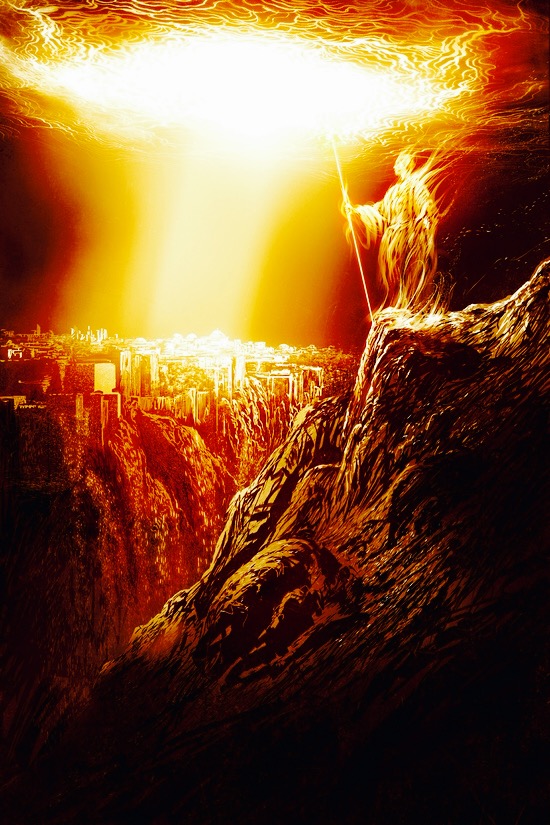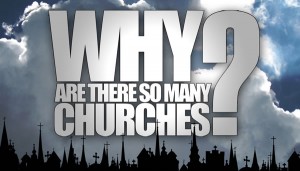In the wake of God’s cataclysmic judgment against the city of man, how should the city of God respond? On one hand, Christians throughout the Empire inevitably lost friends and family as their communities and borders deteriorated. But for those who looked down from heaven upon the onslaught, their response was one of joy, of feasting, and of victory. When hell’s harlot had been defeated, the departed saints could cry out to their Lord, “Hallelujah! . . . Praise our God . . . !” (Rev 19:1, 3, 4, 5, 6 ESV). While judgment fell on Rome, the faithful rejoiced over her downfall (19:1-5); the battle had been won (19:11-21), and the reign of God confirmed (19:6-10).
And yet, surprisingly, it is this victorious reign of God over the rulers of the earth that poses the greatest problem interpreting the book of Revelation (Rev 20:1-6). But neither the actor, the set, or the prop is new: “the ancient serpent,” “the bottomless pit,” and “the key” (20:1). All three appeared before in Revelation 9:1, when Satan (“a star fallen from heaven to earth;” see 12:9) was “given the key to the shaft of the bottomless pit.” From this pit, God allowed him to call forth his demon-driven armies for a time, but Satan’s assault soon focused on a target of God’s choosing: the very city that ruled by the strength of Satan’s power (9:1-21; 13:1-10).
But as John would no doubt remind us, Satan does not own the key to the abyss, it belongs to Christ (Rev 1:18); so we now see it back in the hands of an angel, who “seized the dragon . . . and bound him for a thousand years, and threw him into the pit, and shut it and sealed it over him, so that he might not deceive the nations any longer, until the thousand years were ended. After that he must be released for a little while” (19:2-3).
It’s this last sentence that confuses many people. After all, if Satan is still deceiving the nations (2Co 4:4), doesn’t that mean the millennium is still in the future? And if John says that he will be released again, won’t it be followed by a literal tribulation, then the second coming of Christ? Maybe so. But given Revelation’s symbolic use of numbers, and the breakdown of time throughout the book due to recapitulation, we can’t make confident claims about sequence from these words.
Instead, when we compare the numerical representation of Satan’s influence to the reign of God we are revealed the ultimate, ever-present supremacy of the Great I AM over our Enemy. Satan will trample us for only ten days (Rev 2:10) or maybe even 1,260 (11:2-3), but we will reign with God for one thousand years (10 x 10 x 10 = the number of perfection multiplied to the factor of heaven, 3; Rev 20:4-6). The difference is presented as quantitative because it represents a complete qualitative distinction between the influence of Satan and the reign of God—they’re not even on the same plane.
And for the first-century Asian believers suffering under the imperial cult, this was a great comfort. For in the face of death they found not defeat, but victory: “Then I saw thrones, and seated on them were those to whom the authority to judge was committed. Also I saw the souls of those who had been beheaded for the testimony of Jesus and for the word of God, and those who had not worshiped the beast or its image and had not received its mark on their foreheads or their hands. They came to life and reigned with Christ for a thousand years” (Rev 20:4). The disembodied souls who had previously cried out, “O Sovereign Lord, holy and true, how long . . . ?” (6:9-11) were now reigning with Christ awaiting the resurrection of the dead and the redemption of their bodies (20:-6; 1Th 4:14-17; Rom 8:23; Ecc 12:7; Php 1:19-23; Job 19:25-27).
The millennium therefore serves as a sort of hinge around which Revelation turns. On one hand, the city where God reigns has already been established through creation, and confirmed through Christ’s incarnation, miracles, death, burial, resurrection, and ascension (Heb 11:10, 13-16; Mat 2:2; 12:28; 16:28; Col 1:13). And all those who belong to Christ—whether dead or alive—are children of the heavenly King and heirs according to the promise (2Ti 2:11-13; Gal 3:25-29).
But on the other hand, there is a sense in which we wait in patience and purity for a kingdom yet to come (1Co 15:50; Eph 5:5; 2Ti 4:18; Mat 6:10); though limited in power and freedom, the devil is still on the loose, as are his servants (1Pe 5:8; 2Co 11:13-15). But just as God had destroyed the godless forces of Gog and Magog before (the Seleucids; see Eze 38-39, Summers 206-207), he promises John that he will do so again: “And [Gog and Magog] marched over the broad plain of the earth and surrounded the camp of the saints and the beloved city, but fire came down from heaven and consumed them, and the devil who had deceived them was thrown down into the lake of fire and sulfur where the beast and the false prophet were, and they will be tormented day and night forever and ever” (Rev 20:9-10; see 20:12-15).
And with evil and its servants shoved aside, everything we see will change, “a new heaven and a new earth” will appear, and the city of God will descend from heaven as the radiant bride of Christ (Rev 21:1-2, 9-11; Eph 5:22-27). It will be a place of perfect fellowship: where God descends to dwell (Rev 21:3), where the righteous are at home (21:4-8), and where the sea no longer stands between God and his people (20:11; 4:6; 15:2; 21:1). It will be a place of perfect protection: with 12 foundations, 12 pearly gates, 12 angelic sentries, an area and height of 12,000 stadia, and 144-cubit-thick walls. And the perfect paradise, in which the curses of old have been undone: the serpent has been crushed, the Seed has conquered, the woman is dressed in white, man walks and talks with the Lord in his garden, and God’s children partake freely of the un-forbidden fruit (Mat 19:28; Gen 3; Acts 3:21; Rom 8:18-25).
Whether we realized it or not, though, we’ve also just answered the most difficult question about Revelation: When does the book of Revelation actually talk about us today, and what about the end times? In short, everything until the millennium (Rev 1:1-19:21) found immediate fulfillment in the first-century church, and applies to us today only by extension. And everything from the millennium to the end of the book (20:1-22:21) applies to all Christians in every age, and the one hope all Christians share in an eternity with our Lord (Eph 4:4; 1Th 4:16-17).
In other words, the Book of Revelation has always been about us; we just have to shift our vantage point to see things from the throne room of God (Rev 4-5; 20:1-6). We too have been added by Christ to his kingdom of priests (Rev 1:6, 9), we share in his kingdom life and his kingdom victory (5:10), we are his innumerable army (Rev 7), the witnesses to his resurrection from the dead (11:1-14), the disciples clothed in his own righteousness (14:1-5), and the citizens of his own eternal city (19:1-22:5). As the church of Jesus Christ, we are the saints who live in the last days, the millennial reign of the Messiah (Acts 2:17; 2Ti 3:1; Heb 1:2; Jam 5:3; 2Pe 3:3).
And the promise of that city remains open to all: “The one who conquers . . . I will write on him the name of my God, and the name of the city of my God, the new Jerusalem, which comes down from my God out of heaven, and my own new name. . . . Blessed are those who [do his commandments], so that they may have the right to the tree of life and that they may enter the city by the gates” (Rev 3:12; 22:14; see ESV margin).
The following files are now available for free viewing and download:
Attachments
- 07 Slides: The Two Cities (Rev 17:1-22:5)
Audio Recordings **All but Part 3 are currently pending upload**
- Week 34: The Two Cities, Part 3 (19:1-10)
- Week 35: The Two Cities, Part 4 (19:11-20:6)
- Week 36: The Two Cities, Part 5 (20:1-6)
- Week 37: The Two Cities, Part 6 (20:7-21:8)
- Week 38: The Two Cities, Part 7 (21:9-22:5)
Works Cited
- The ESV Study Bible. Ed. Lane T. Dennis & Wayne Grudem. Crossway, 2008. Accordance.
- Freeman, Charles. Egypt, Greece and Rome. 2nd Ed. Oxford, 2004. Print.
- Summers, Ray. Worthy is the Lamb: An Interpretation of Revelation. Nashville: Broadman, 1951. Print.
Cross-posted from In His Image.





